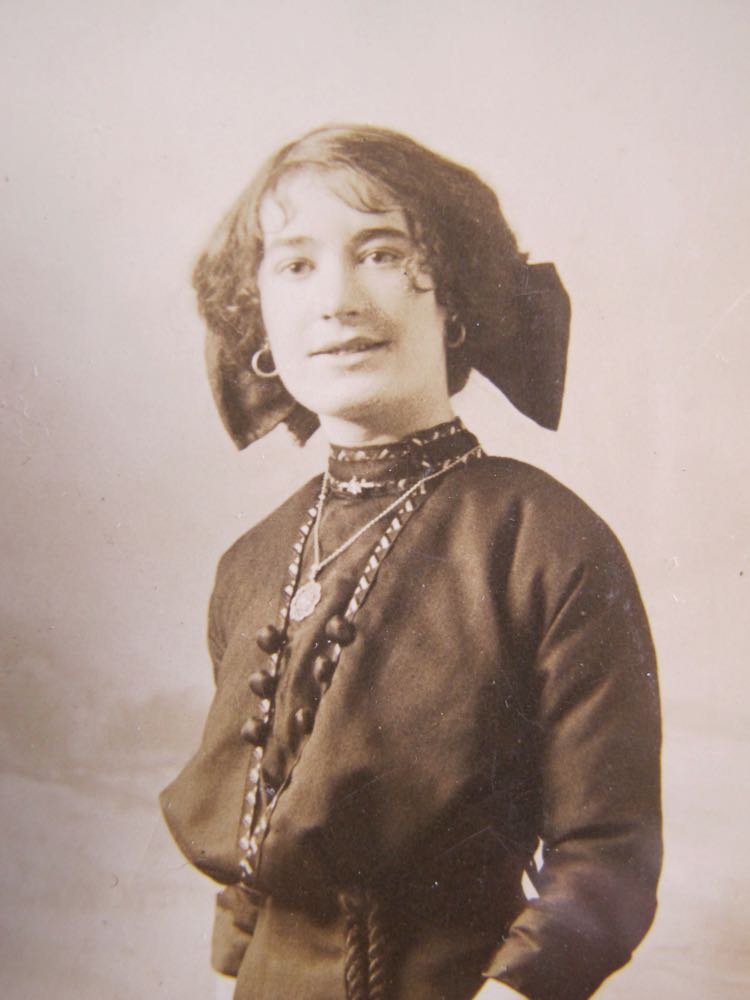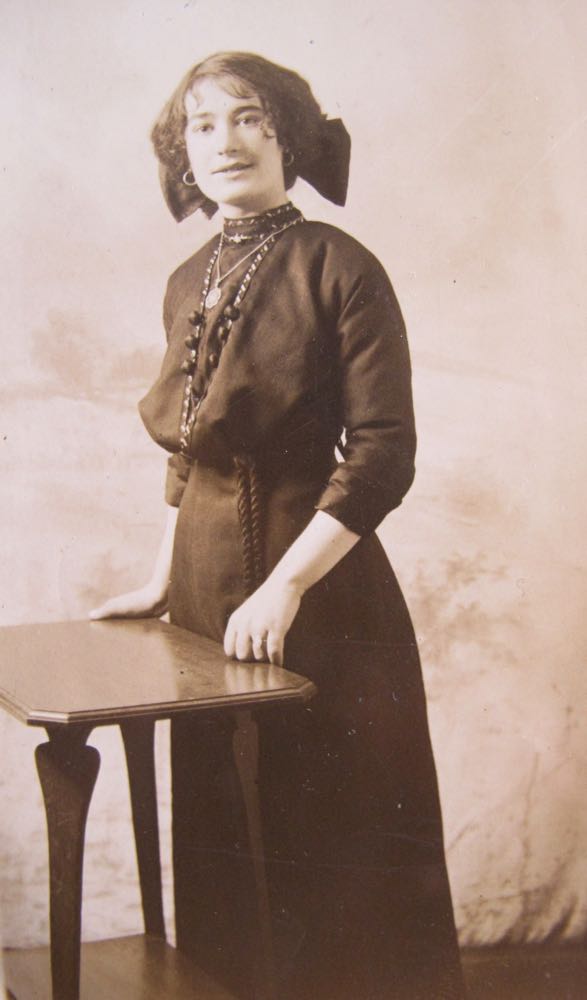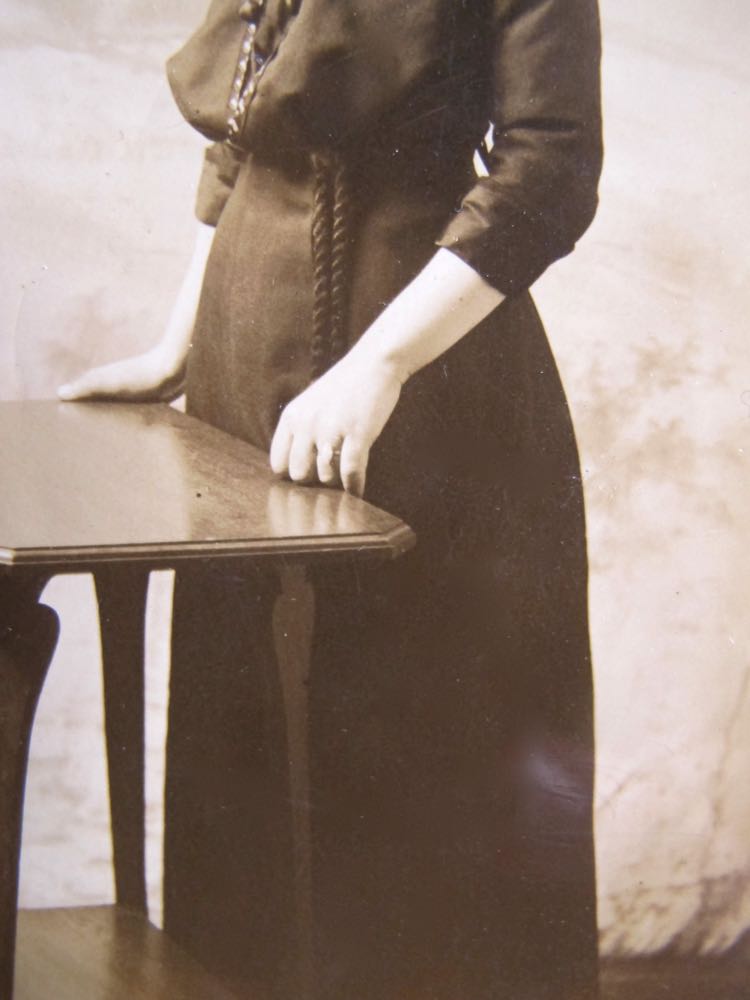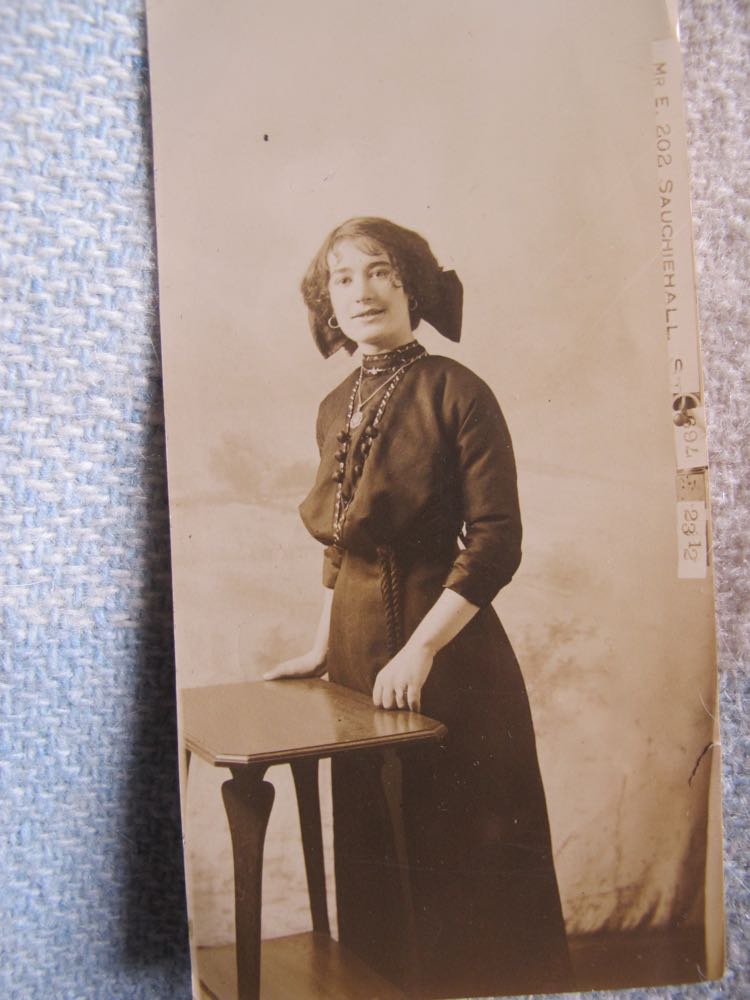I like picking up old photographs when I find them at antique stores and op shops.
Partly I do it because old photographs are fantastic clothing research resources, and partly I do it because it seems so sad that there was a time when people knew them, and knew who they were, and valued and treasured their photographs, and now that link is broken.
I’ll never know who most of the people I find in images were, but I can at least carry on a little tidbit of their story.
This woman is one of my favourite recent finds:
I say woman, because while she’s clearly quite young, and her elaborate hair-bows are very girlish, she appears to be proudly displaying a rather large and gorgeous engagement ring on her left hand.
Her outfit is absolutely typical of 1913: skirts had been getting slimmer and higher since 1910, and the cut-on Magyar sleeves were very stylish beginning in 1913. In a formal studio setting, taking a photograph to commemorate her engagement, she was probably wearing up to date clothing, so I feel comfortable definitively dating the photograph to 1913 or 1914.
It is possible that her hair bow and earrings indicate a regional style, but there is nothing that is definitely out of place for a typical 1913 look. Her outfit has some beautiful details: the heavy rope belt hanging from her waist, the slight sheen of satin at her cuffs, and the geometric trim on her bodice.
You can see where the bodice fastens around the neck on the left, and then would open under the trim on the proper left front. If her outfit is a blouse and skirt, the opening would continue down the front of the blouse. If it’s a dress, it could continue down the front of the dress, and then the skirt might fasten under the rope detailing at front, or the front neck opening would only go partway down, and there would be a second closure in back, or at the side, to allow the fit at the waist.
It’s amazing the detail I can get out of the photograph, as the original is very small: only 6cm (2 3/8″) across and 11.5cm tall (4 1/2″).





They enlarge magnificently, those older photos, even the later ones from the Box Brownie that so many of us have in our photo collections.
Sauchiehall Street is the main street of Glasgow, and 202 was built in 1902.
Beautiful young lady, and really interesting outfit.
Oh fantastic! Thank you! I hadn’t gotten around to researching the image yet.
H.L. Lloyd is listed as a Photographic Artist at that address in the 1912 Glasgow Post Office annual directory.
Oh, you are a wonder!
You have been a little busy. Understatement.
The level of detail in the photo is amazing! Would I be right in thinking this is an example of artistic dress?
I think it definitely has a very slightly artistic/bohemian twist to it, but it’s still fairly conventional. I’ve got some ‘how to dress’ guides of the period for teenage girls, and they say that you should decide what your style is: sporty, winsome, artistic, etc, and also give advice on what styles suit what looks (i.e, you shouldn’t go for ‘winsome’ with lots of ruffles, if you are larger and have very strong features). So I don’t think it’s really strongly defined or hugely out of the mainstream.
I literally walk past 202 every lunchtime. How amazing!!
I’m wondering (and revealing my ignorance I’m sure) what the excess of fabric is at the lower front. I can’t quite figure out what is going on there?
How neat! Any chance you could take a photo so we can see what it looks like.
What you’re seeing is the remains of the Edwardian pigeon breast. So the garment is designed to have all that extra fabric.
But doesn’t all that extra fabric below her bust point look strange? It’s almost as if she is wearing a dress designed for a matronly woman.
To modern eyes, yes, but that was absolutely the fashion. Her dress is right by the style of 1913. Matronly busts were the desired look, so dresses were cut that way – extremely fashionable woman supplemented what they had with padding, but otherwise the look was loose. It may have been a ready-made blouse, which would have been made for the most fashionable figure. Compare to this image, which is a posed fashion photograph
I wonder what happened with this young woman. Here she is possibly engaged around 1913—14 and then the Great War begins. Did she marry before it started? Did her husband/sweetheart go off to the trenches? Did he survive? Did she have children with him? Was she happy?
I’ve had exactly the same thoughts!
Lovely photo, and it’s so neat to hear from Shirley who passes by the photography studio building every day! Would love to know how things turned out. I never got in the habit of writing names on the back of photos, but this sort of thing makes me think I ought to get an acid-free pen and get to it.
Is it just me or does she look like Anna Paquin?
I’ve had exactly that thought too!